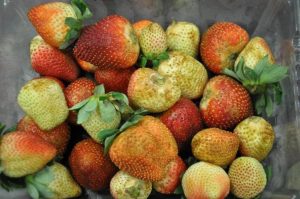Watch Out for Thrips Coming From Southerly Winds
Thrips tend to move into plantings on early spring wind storms from Southern states and can cause significant damage to June-bearing strawberry. In early summer last year (2022), several growers reported having extensive damage from thrips even though they had not noticed thrips on traps or plants. At this time, it is very important to remember to scout early in the season to detect thrips and trigger appropriate management strategies. To monitor for thrips, it is usually recommended to shake or tap 10 blossoms per site at 10 or more sites per variety over a white bowl or tray. Action thresholds of 2-10 thrips per flower or small berry may warrant a chemical control, depending on your level of tolerance (for more info see previous article on thrips). While this is the standard monitoring method, we have noticed that direct observations of thrips on flowers and leaves reveal many more thrips than the tapping/shaking method. This could help explain why some growers may have missed the early presence of thrips last season. Sticky cards can also be used to monitor thrips populations, though no threshold has been established for sticky cards. Finally, scouting for damage symptoms directly on fruit as soon as fruit is present is very important to ensure proper management strategies can be implemented swiftly. For pictures of bronzing or discoloration symptoms and small hard and seedy berries, please refer to this Ohio State University article or see Figure 1 as an example.

Thus, I highly recommend strawberry growers look directly at 10 plants per site at 5 to 10 different areas depending on the size of the fields at least once a week and particularly following southernly wind patterns to assess for the presence of thrips. I recommend implementing chemical control if more than 5 thrips per flower are found. Scouting should continue until fruit has reached ~1/2 inch diameter. 50 fruit in each area should be examined or removed and placed in individually in Ziploc bags. Bags can be placed in the sun so that the heat makes the thrips move around and easier to count. When fruit has reached ¼ inch in diameter, the action threshold of 0.5 thrips per fruit can be used to trigger a chemical control. Recommended insecticides include pyrethroids (e.g., Danitol, Brigade), Spinosyns (e.g., Entrust, Radiant, Delegate), and neonicotinoids (e.g., Assail). In organic production, Entrust, Aza-Direct, Grandevo, Pyganic, and other product listed on this Ohio State University article can provide good control of thrips. As thrips can be present at bloom time, it is important to consider pollinators when planning to apply chemical controls. It is best to avoid spraying during bloom and it is recommended to spray before blossoms open or before 10% of plants have open blossoms, using early blooming cultivars as a warning for later cultivars that can be sprayed preventatively before bloom. If there is a need to spray during bloom, it is best to use products that are less toxic to bees. For more information on how to select pesticides, please see this Oregon State publication or download the app “Reduce bee poisoning from pesticides”.
For more information about mites, tarnished plant bug, or thrips in strawberry, please refer to this previous article.
Happy growing season!
This article was posted in Insects and tagged Christelle Guédot, insects, Strawberries, Thrips.
